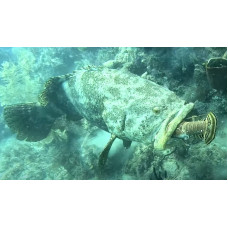Latin name
Epinephelus lanceolatus
Other names
Queensland groper (grouper), brindle grouper, mottled-brown sea bass.
Identification
The body is powerful. The height of the body is 2.4-3.4 times the length of the fish, and the thickness of the body is only 1.5-1.75 times less than the height. The length of the large head is 2.2-2.7 times less than the length of the body. The eyes are small, their diameter is 6-14 times less than the length of the head. The upper jaw comes behind the vertical edge of the eye. The lower jaw has 2-3 (in juveniles) to 15-16 (in adults) lateral rows of teeth. Juveniles have 8-10 gill stamens on the upper part of the ray and 14-17 gill stamens on the lower part; gill stamens are reduced in adults. Lateral line with 54-62 scales.
Features of fish fins
Long dorsal fin with 11 hard barb rays and 14-16 soft rays. Anal fin with 3 hard and 8 soft rays. Caudal fin rounded. Dorsal fin spines not equal from third to eleventh, shorter than longest soft rays. Pelvic fins short.
Fish colouring
The coloration changes during the life cycle. The body of juveniles is yellow with three broad dark stripes. The first interrupted stripe runs from the base of the dorsal fin to the belly and extends to the thorax and head. The second begins at the base of the soft part of the dorsal fin and extends to the base of the anal fin. The third band is at the base of the caudal fin. Individuals 20 to 50 cm in length have scattered white or yellow areas on a dark body, fins with chaotic black spots. Adults 80 to 150 cm long are dark brown with indistinct spots on the body, fins with numerous small black spots. Large individuals (160 to 230 cm long) are dark brown with darker fins.
Distribution
The most widespread member of the grouper family. In the Indian Ocean, it is found from the Red Sea along the coast of Africa to Algoa Bay (South Africa), and also near Madagascar, the peninsulas of Hindustan and Indochina, and some oceanic islands; it is absent from the Persian Gulf. In the Pacific Ocean, it is distributed from southern Japan to New South Wales (Australia) and in the central Pacific as far east as Hawaii and the Pitcairn Islands. Occasional sightings off southern Australia.
Habitat
Marine, brackish, tropical species. Benthopelagic and benthic. Occupies coastal areas at depths down to 100 m, but usually at shallower depths. Usually found in crevices, caves in coral reefs, near large rocks and shipwrecks. Juveniles and adults have been observed in estuaries. They lead a solitary life. Groupers actively defend their territory and can cause serious injury to humans.
Size
Maximum body length is 270 cm. Normal length is 190 cm. Body weight up to 400 kg.
Behavior
They lead solitary lives.
Food and feeding habits
A predator that usually waits for its prey in an ambush: a crevice, between rocks, in thickets of algae or coral. The preferred food is lobster. It also feeds on crabs, various fish, including small sharks and rays, and young sea turtles. The mouth apparatus is adapted for strong suction, with water flowing into the mouth and the prey, which the grouper swallows whole.
Reproduction
Like other representatives of the genus, it is a consecutive protogynous hermaphrodite. At the beginning of the life cycle all individuals are exclusively female, and only a part of adult fish changes sex and becomes male. Fertilization is external. Eggs and larvae are pelagic.
Fishing
Due to its low abundance, it is not subject to specialized fisheries. It is caught as bycatch in longline fisheries. It is a popular target for underwater hunting with harpoon or underwater gun.
Relationship with a person
Groupers actively defend their territory and can cause serious injury to humans.
Some countries have begun to breed them under artificial conditions.
Large individuals can be toxic to the human body.
| Classification | |
| Phylum | Chordata |
| Class | Actinopterygii |
| Squad | Perciformes |
| Family | Serranidae |
| Genus | Epinephelus |
| Species | E. lanceolatus |
| Features | |
| Conservation status | Data Deficient |
| Habitat | Pelagic |
| Life span, years | No information |
| Maximum body weight, kg | 400 |
| Maximum length, cm | 270 |
| Sailing speed, m/s | No information |
| Threat to people | Edible |
| Way of eating | Predator |
Giant grouper
Tags: giant grouper


